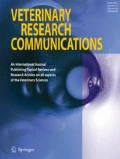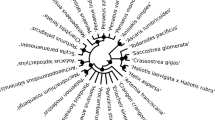Abstract
Appreciation of species variation in response to drugs is essential for the most effective application of available drugs in each species. Such variation may be due to differences in responding systems in different species. These may be: anatomical or histological differences; differences in receptor type and distribution; or differences in the nature and distribution of intermediary substances.
This paper discusses examples of species differences in response related to pharmacodynamics, concentrating on 4 groups of substances: namely substances (1) involved in anaphylactic reactions, (2) acting on the sympathetic nervous system, (3) affecting the central nervous system, and (4) with effects on the reproductive system.
-
(1)
In anaphylactic reactions the release, distribution and effects of mediators, including histamine, 5-hydroxytryptamine, dopamine, kinins, slow reacting substance of anaphylaxis (SRS-A), eosinophil chemotactic factor, neutrophil chemotactic factor, platelet activating factor and prostaglandins, vary. The distribution of H1 and H2-histamine receptors for example varies even between different species of ruminants. Successful inhibition of anaphylactic or allergic reactions necessitates the correct choice of antagonist for the affected species, e.g. antihistamines may be expected to be effective in guinea pigs and dogs but prostaglandin antagonists would be more useful in cattle.
-
(2)
Sympathomimetics and α and β adrenergic receptor blocking drugs have different metabolic effects and effects on sweating in different species, e.g. horses, ruminants and rats.
-
(3)
Substances, including analgesics and anaesthetics, which affect the central nervous system, may produce depression in some species but excitation in others (e.g. morphine, ketamine) due to differences in distribution of neurotransmitters. Some drug susceptibilities are genetically controlled.
-
(4)
The effects of substances on the reproductive systems of different species can be more readily predicted as differences in the regulation of oestrus are appreciated.
Species variation in responses to immunostimulants and antibiotics are also referred to.
Theoretically the responses of different species to a given drug might be predicted from a full understanding of the pharmacology of the drug and of comparative physiology, biochemistry and anatomy. In practice this is frequently not possible.
Similar content being viewed by others
References
Ahlquist, R.P., 1948. A study of the adrenotropic receptors. Am. J. Physiol., 153: 586.
Aitken, M.M. and Sanford, J., 1972. Modification of acute systemic anaphylaxis of cattle by drugs and by vagotomy. J. Comp. Pathol., 82: 247.
Aitken, M.M. and Sanford, J., 1975. Effects of prostaglandins in calves. Br. J. Pharmacol., 54: 266P.
Allen, N.M.S., Berrett, S., Harding, J.D.J. and Patterson, D.S.P., 1970. Experimentally induced acute stress syndrome in Pietrain pigs. Vet. Rec., 87: 64.
Allen, W.R., 1977. In: D.B. Caighton, N.B. Haynes, G.R. Foxcroft and G.E. Lamming (Eds), Control of Ovulation. Butterworths, London, Boston, Sydney, Wellington, Durban, Toronto, p. 453.
Anderson, L.L., 1977. In: R.M. Wynn (Ed.), Biology of the Uterus. Plenum Press, New York and London, p. 587.
Anderson, M.G. and Aitken, M.M., 1977. Biochemical and physiological effects of catecholamine administration in the horse. Res. Vet. Sci., 22: 357.
Antonis, A., Clark, M.L., Hodge, R.L., Molony, M. and Pilkington, T.R.E., 1967. Receptor mechanisms in the hyperglycaemic response to adrenaline in man. Lancet, i, 1135.
Ashford, C.A., Heller, H. and Smart, G.A., 1949. The effects of antihistamine substances on gastric secretion. J. Pharmacol. Chemother., 4: 153.
Atkinson, G., Bogan, J.A., Breeze, R.G., and Selman, I.E., 1977. Effects of 3-methylindole in cattle. Br. J. Pharmacol., 61: 285.
Bergstrom, S.L.A., Carlson, L.A. and Weeks, J.R., 1968. The prostaglandins: a family of biologically active lipids. Pharmacol. Rev., 20: 1.
Black, J.W., Duncan, W.A.M., Durant, C.J., Gaellin, C.R. and Parsons, E.M., 1972. Definition and antagonism of histamine H2 receptors. Nature, 236: 385.
Boobis, A.R., 1979. In: J.W. Gorrod (Ed.), Drug Toxicity. Taylor & Francis Ltd., London, p. 51.
Booth, N.H., 1977. In: L.M. Jones, N.G. Booth and L.E. McDonald (Eds), Veterinary Pharmacology and Therapeutics, 4th Edition. The Iowa State University Press, p. 318.
Carlson, J.R., Dyer, J.A. and Johnson, R.J., 1968. Tryptophan-induced interstitial pulmonary emphysema in cattle. Am. J. Vet. Res., 29: 1983.
Chand, N., 1979. Pharmacological basis of immediate hypersensitivity in the domestic fowl: a review. J. Vet. Pharmacol. Therapeutics, 2: 151.
Cook, W.R., 1973. Diarrhoea in the horse associated with stress and tetracycline therapy. Vet. Rec. 93: 15.
Cooper, M.J., 1977. In: D.B. Crighton, N.B. Haynes, G.R. Foxcroft and G.E. Lamming (Eds), Control of Ovulation. Butterworths, London, Boston, Sydney, Wellington, Durban, Toronto, p. 413.
Cotton, D.W.K. and Van Hasselt, P., 1972. Innervation of the sweat glands in horses and dogs. Br. J. Dermatol., 87: 80.
David, L.E. and Donnelly, E.J., 1968. Analgesic drugs in the cat. J. Am. Vet. Med. Assoc., 153: 1161.
Dhasmana, K.M., Dixit, K.S., Jaju, B.P. and Gupta, M.L., 1972. Role of dopaminergic receptors in manic response of cats to morphine. Psychopharmacologica, 24: 380.
Donald, D.E., Ferguson, D.A. and Milburn, S.E., 1968. Effect of beta-adrenergic receptor blockade on racing performance of greyhounds with normal and with denervated hearts. Circulation Res., 22: 127.
Eikelenboom, G. and Sybesma, W., 1975. Porcine malignant hyperthermia, oxidative metabolism and halothane. Proc. Assoc. Veterinary Anaesthetists of Great Britain and Ireland, No. 5, p. 6.
Epstein, S.E., Robinson, B.F., Kahler, R.L. and Braunwald, E., 1965. Effects of beta-adrenergic blockade on the cardiac response to maximal and sub-maximal exercise in man. J. Clin. Invest., 44: 1745.
Evans, C.L., 1966. Physiological mechanisms that underlie sweating in the horse. Br. Vet. J., 122: 117.
Eyre, P., 1973. Histamine H2-receptors in the sheep bronchus and cat trachea: the action of burimamide. Br. J. Pharmacol., 48: 321.
Eyre, P., 1975. Comparisons of reactivity of pulmonary vascular and airway smooth muscle of sheep and calf to tryptamine analogues, histamine and antigen. Am. J. Vet. Res., 36: 1081.
Eyre, P. and Burka, J.F., 1978. Hypersensitivity in cattle and sheep: a pharmacological review. J. Vet. Pharmacol. Therapeutics, 1: 97.
Farrar, W.E. and Kent, T.H., 1965. Enteritis and coliform bacteraemia in guinea pigs given penicillin. Am. J. Pathol., 47: 629.
Findlay, J.D. and Robertshaw, D., 1965. The role of the sympatho-adrenal system in the control of sweating in the ox. J. Physiol. London, 179: 285.
Fleming, W.W. and Kenny, A.D., 1964. The effect of fasting on the hyperglycaemic responses to catecholamines in rats. Br. J. Pharmacol., 22: 267.
Fitzpatrick, R.J., 1977. The medical induction of parturition. Association for Veterinary Clinical Pharmacology and Therapeutics Summaries and News. No. 1, p. 14.
Gollnick, P.D., Soule, R.G., Taylor, A.W., Williams, C. and Ianuzzo, C.D., 1970. Exercise-induced glycogenolysis and lipolysis in the rat: hormonal influence. Am. J. Physiol., 219: 729.
Hammond, D., 1977. The use of prostaglandins in the pig. Association for Veterinary Clinical Pharmacology and Therapeutics Summaries and News. No. 1, p. 18.
Haresign, W., 1977. In: D.B. Crighton, N.B. Haynes, G.R. Foxcroft and G.E. Lamming (Eds), Control of Ovulation. Butterworths, London, Boston, Sydney, Wellington, Durban, Toronto, p. 435.
Heavner, J.E., 1970. Morphine for post surgical use in cats. J. Am. Vet. Med. Assoc., 156: 1018.
Lands, A.M., Arnold, A., McAuliff, J.P., Luduena, F.P. and Brown, T.G. Jnr., 1967. Differentiation of receptor systems activated by sympathomimetic amines. Nature, London, 214: 597.
Mayer, S., Moran, N.C. and Fain, J., 1961. The effect of adrenergic blocking agents on some metabolic actions of catecholamines. J. Pharmacol. Exp. Therapeutics, 134: 18.
Portier, R. and Richet, C., 1902. De l'action anaphylactique de certains venins. C. R. Seances Soc. Biol., 54: 170.
Robertshaw, D., 1968. The pattern and control of sweating in the sheep and the goat. J. Physiol., London, 198: 531.
Snow, D.H., 1977. Identification of the receptor involved in adrenaline mediated sweating in the horse. Res. Vet. Sci., 23: 246.
Snow, D.H., Summers, J.J. and Guy, P.S., 1978a. The action of the β-adrenocepter blocking agents propranolol and metaprolol in the maximally exercised horse. Res. Vet. Sci., 27: 22.
Snow, D.H., 1979b. Metabolic and physiological effects of adrenoceptor agonists and antagonists in the horse. Res. Vet. Sci., 27: 372.
Sweatman, W.J.F. and Collier, H.O.J., 1968. Effects of prostaglandins on human bronchial muscle. Nature, 217: 69.
Vendsalu, A., 1960. Adrenaline and noradrenaline in human plasma. Acta Physiol. Scand., 49: Supplement 173.
Webb, A.J., 1980. The halothane test: A practical method of eliminating porcine stress syndrome. Vet. Rec., 106: 410.
Wilson, R.D., Dent, T.E., Traber, D.L., McCoy, N.R. and Allen, C.R., 1967. Malignant hyperpyrexia with anaesthesia. J. Am. Med. Assoc., 202: 111.
Author information
Authors and Affiliations
Rights and permissions
About this article
Cite this article
Aitken, M.M. Species differences in pharmacodynamics: Some examples. Vet Res Commun 7, 313–324 (1983). https://doi.org/10.1007/BF02228640
Issue Date:
DOI: https://doi.org/10.1007/BF02228640




